
MAY CONTAIN NUTS

Search Shorpy
SHORPY ART

Framed or unframed, desk size to sofa size, printed by us in Arizona and Alabama since 2007. Explore now.
Join and Share
Ad-Free Shorpy
Shorpy is funded by you. Patreon contributors get an ad-free experience.
Learn more.

Recent comments
- Pinstripes in the Tower
- Sound enhancement
- 3438 in '38
- Second Career
- Their days are numbered
- Only the Sensor
- Train control mechanism
- Rarest of the Rare?? & Classy 3400 Class
- Control Mechanism
- Those standpipes
- Wrenches
- International D-40 I believe
- Job prospects
- You had me at Train
- Land of the free
- Broad-Exchange Bldg
- Parking innovation
- The old block
- "Peck turned a sweet propeller"
- National Bank Building
- Notch shot
- Straight ahead (right, left, left, right)
- Ship lifespans
- New service
- You Say Station, I Say Potato ...
- Iron Age
- Thank you, Cornelius Vanderbilt
- Grand Central Terminal
- If they made a movie of it
- Obsolete by then.
Member Photos
The Shorpy
Printporium
Printporium
Search Shorpy
Search results -- 30 results per page
- Hang On There: 1914
- ...
Patiently posed An article in Life Magazine from 1937 describes how the animals are patiently posed, and often distracted to get ... Posted by Dave - 04/17/2014 - 12:15pm -
![Hang On There: 1914 1914. "Cats in coveralls on chin-up bar." Photo by Harry Whittier Frees, patient poser of anthropomorphic puppies and kitschy kittens. View full size.
QuestionDoes anyone know if these animals are alive or stuffed? Thanks.
[One hundred years later, they're neither. - Dave]
Stuffed Animals"Harry Whittier Frees (1879–1953) was an American photographer who created novelty postcards and children's books based on his photographs of taxidermied animals." -from Wikipedia.
[Wikipedia's "support" for that assertion is merely another unsupported assertion. -tterrace]
Patiently posedAn article in Life Magazine from 1937 describes how the animals are patiently posed, and often distracted to get the right reaction. Many shots are spoiled and he uses a fast shutter speed.
There are other books written by and about the photographer where his method is described.
Frees used live subjects...and had to spoil many negatives, as they moved and played around. His costumes helped hold a kitty or puppy to a pose, but were not confining to young, squirmy pets. Frees only photographed about 3 months a year because the work was so "nerve-racking."
See this.
(The Gallery, Cats, Harry W. Frees)](https://www.shorpy.com/files/images/SHORPY_04040u.thumbnail.jpg)
- Grandfather of All: 1935
- ... on Dec. 16, 1935. The exodus of residents took place in 1937.
Casting Call Nowadays, Grandpa Russ could clean up as a Robert E. ... Posted by Dave - 12/06/2015 - 7:39pm -
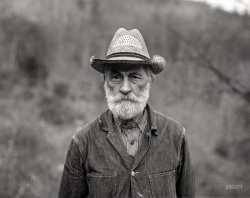
- Pocono Depot: 1905
- ... all day. Sadly, it was at least partially demolished in 1937. I hate to imagine what cinder-block cube might occupy the space today. ... Posted by Dave - 04/04/2018 - 10:53am -
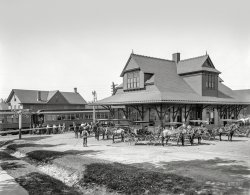
- Deluxe Wash: 1942
- ... rebuilt from older 2-10-2s in IC's Paducah Shops between 1937 and 1943.
(The Gallery, Chicago, Jack Delano, Railroads) ... Posted by Dave - 05/08/2015 - 1:33pm -
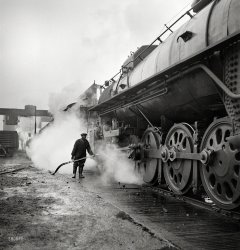
- Rhinelander Row: 1936
- ... Avenue between 12th and 13th Streets (demolished in 1937)." 5x7 inch acetate negative by Arnold Moses for the Historic American ... Posted by Dave - 05/01/2019 - 1:04pm -
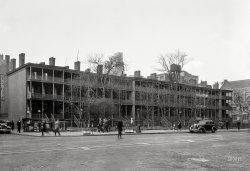
- Sarasota Celery: 1941
- ... Administration. View full size.
Sure is pretty 1937 Ford pickup.
Comment trio Since I have three comments to make on ... Posted by Dave - 09/18/2019 - 7:46pm -
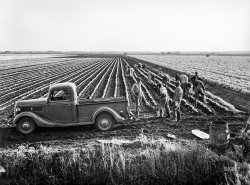
- Allen-Bradley: 1940
- ... light Manufactured by General Electric between roughly 1937 and 1950, this is the Novalux sectionalized signal . The lenses are ... Posted by Dave - 02/16/2017 - 1:47pm -
![Allen-Bradley: 1940 December 1940. "Putting up a new traffic signal in San Diego." Photo by Russell Lee for the Farm Security Administration. View full size.
The traffic lightManufactured by General Electric between roughly 1937 and 1950, this is the Novalux sectionalized signal. The lenses are commonly referred to as "spiderweb" style and if you look closely you can see the GE logo embedded in the center of the lens. The pic below is one from my collection.
Interesting that they painted these in the field after installation instead of beforehand.
New Problems Don't Always Make Older BetterYeah LEDs don't get hot enough to melt snow, but with the amount of money saved in electricity and re-lamping (LED signals use about 1/10 the electricity of incandescents, and last about 10 times longer) they can afford a crew to go out and blow off the signals with compressed air or brush them off with a pole the very few times a year when it might matter.
[U.S. Patent 7211771 B1, "De-Icing System for Traffic Signals." -Dave]
Older Was BetterYou all may have noticed the proliferation of LED traffic signals in your area. I can tell you that in Erie, PA, the new ones don't get hot enough to melt the snow that blows into them. Same with LED marker signals and headlights on cars. Newer ain't necessarily better.
(The Gallery, Cars, Trucks, Buses, Russell Lee)](https://www.shorpy.com/files/images/SHORPY-00070u1.thumbnail.jpg)
- National Brands: 1941
- ... Security Administration. View full size.
Car ID 1937 Graham Crusader.
Non-PC Car Names Good eye, Hayslip. That's a very ... Posted by Dave - 03/20/2020 - 7:26pm -
![National Brands: 1941 August 1941. "Building in Ewen, Michigan, former lumber town on the Upper Peninsula." Acetate negative by John Vachon for the Farm Security Administration. View full size.
Car ID1937 Graham Crusader.
Non-PC Car NamesGood eye, Hayslip. That's a very obscure auto to identify. "Crusader" would definitely not fly as an appropriate model name in today's world. Neither would the Studebaker "Dictator." In fact, "Dictator" probably became non-PC in the U.S. sometime around December 7, 1941.
[And who could forget the Fiat Fascist? - Dave]
Not the UtilityThe window is advertising Power House candy bars, made by Peter Paul (discontinued).
(The Gallery, John Vachon, Small Towns, Stores & Markets)](https://www.shorpy.com/files/images/SHORPY-8c19952a.thumbnail.jpg)
- Peel Me a Carrot: 1940
- ... outlets per room would have been enough to comply with the 1937 National Electrical Code, and they didn't need to be anywhere near the ... Posted by Dave - 07/26/2018 - 10:55pm -
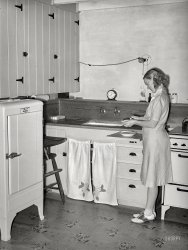
- Jailbirds: 1940
- ... there This building was erected on Guadalupe Street in 1937 and served until the new correctional center was opened in 1989; it was ... Posted by Dave - 07/21/2018 - 12:43pm -
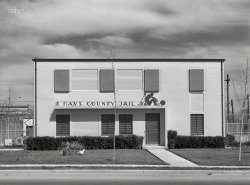
- Jolly Rancher: 1941
- ... Security Administration project. He has been here since 1937. He came from around Crawford, Nebraska, an extremely dry section with no ... Posted by Dave - 02/19/2015 - 10:35am -
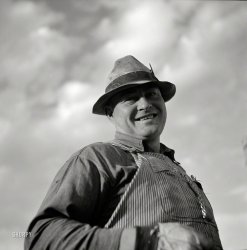
- Janet Whitton Moffett with President Calvin Coolidge, 1926
- ... who must have been an inspiration, didn't die until 1937.
What was the rest of her life story? Did you know her? She'd make a ... Posted by kenmay - 10/14/2009 - 10:22am -
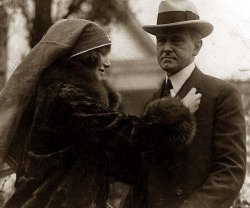
- Bright Eyes: 1931
- ... of company CEO E.L. Cord, and had disappeared by 1937.
Amanuensis I had to look that one up, and now I know a new word! ... Posted by Dave - 04/08/2015 - 11:48am -
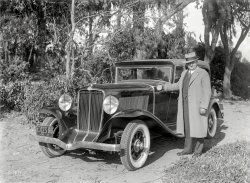
- Paris Wheel
- ... has been a financial disaster, and it has been removed in 1937.
Some 50' then 70's buildings have been built there.
You can imagine ... Posted by LindseyKBrennan - 07/10/2008 - 11:39pm -
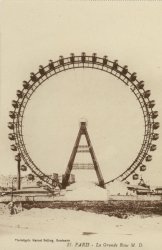
- The Old Mint: 1940
- ... Parking The car closest to the guys on the steps is a 1937 Dodge 4-door Trunk Sedan with 185,483 built. This was by far Dodge's ... Posted by Dave - 04/21/2014 - 12:10pm -
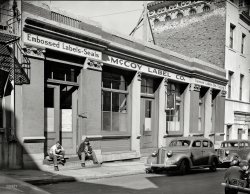
- Chicago, Burlington & Quincy 4000
- ... locomotive, CB&Q #4000 was dressed with a shroud in 1937 and named "Aeolus" (keeper of the wind). I would imagine that during the ... Posted by Atomic Rocket - 09/20/2011 - 10:22pm -
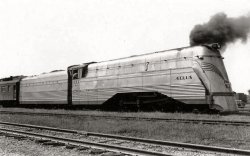
- Bus Stop: 1943
- ... 743 (diesel powered, with air conditioning) came along in 1937. Yellow made both models until around 1939.
A restored Yellow 743 ... Posted by Dave - 06/08/2018 - 4:17pm -
![Bus Stop: 1943 September 1943. "A Greyhound bus that has been stopped at a filling station to get water between Washington, D.C., and Pittsburgh." Medium format nitrate negative by Esther Bubley for the Office of War Information. View full size.
A Raymond Loewy beautyThe bus in question is "Yellow Coach" model 743 or 719 (not enough of the photo to tell which). This bus was a real ground-breaker in terms of design.
The Yellow 719 "Super Coach" was the first truly modern interstate bus. Designed by Ray Loewy, this bus was a totally new concept in that it was the first to have a raised passenger deck with a large luggage space underneath between the axles. All modern interstate buses still have that same design. The 719 (gasoline-powered) was made from 1936 and the similar 743 (diesel powered, with air conditioning) came along in 1937. Yellow made both models until around 1939.
A restored Yellow 743 coach may be seen here:
https://www.flickr.com/photos/busdudedotcom/15800920762/
A smoking gunCouldn't help notice he's pouring gas into a bus while smoking a cigarette. Hmmmmm. A disaster just waiting to happen.
[Hmmm. Did you READ THE CAPTION? That's water, not gas. (And what bus company or filling station would ever use a garden watering can for fueling?) - Dave]
AS I SAID earlier, yes, I missed the word 'water'. Reading it again, I thought it was gas. My mistake.
(The Gallery, Esther Bubley, Gas Stations)](https://www.shorpy.com/files/images/SHORPY-8d32733a.thumbnail.jpg)
- Happy Hour: 195x
- ... and patented by Walter’s son, Desmond Molins, in 1937. The hinge-lid pack was a major step forward from the previous soft packs, ... Posted by Vintagetvs - 01/06/2017 - 7:17pm -

- Chandler Hall: 1901
- ... College and Downtown Hanover by Frank J Barrett - "By 1937, considered by many as 'unquestionably the ugliest building in Hanover,' ... Posted by Dave - 07/22/2017 - 6:32am -
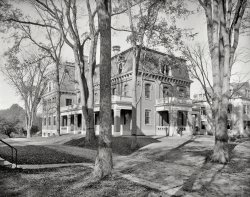
- On Mt. Monadnock
- Taken in 1937, this is labeled Wesley Foundation of Grace Methodist Church, Keene, N.H. ... Posted by k2 - 10/06/2009 - 9:32am -

- Midland King: 1910
- ... The vessel was scrapped at Hamilton, Ontario, in 1937.
(The Gallery, Boats & Bridges, Cleveland, DPC, Railroads) ... Posted by Dave - 10/14/2018 - 3:45pm -
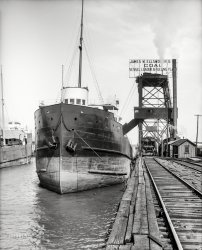
- Elmer & Emma Wise: 1913
- ... returned to Pennsylvania in 1919 but then came back in 1937 at the request of Gray and worked with Gar Wood and Ed Gray at Gray's ... Posted by OldDetroit - 02/01/2013 - 9:04pm -

- Minivan in Color
- Colorized version of Minivan 1937. They look a lot better off in color. View full size.
(Colorized ... Posted by motobean - 01/12/2010 - 8:15am -
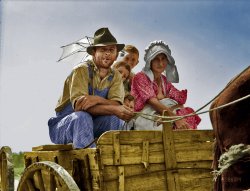
- John H. Spain
- ... there prior to Walter's death - and then John's, in 1937.
View Larger Map
(ShorpyBlog, Member Gallery) ... Posted by chazlemay - 04/18/2009 - 9:41am -

- Budapest Marketplace
- Taken in Budapest, Hungary 1937. View full size.
Blaha Lujza square in Budapest This is the ... Posted by chiliangel - 01/15/2012 - 4:10pm -

- Kaiser's Palace Berlin
- ... Wagner posing opposite the Kaiser's Palace, Berlin, 1937. View full size.
What a difference What a difference a few ... Posted by chiliangel - 01/13/2012 - 9:45am -

- My First RV
- On our farm in Saugus, Mass, 1937. I now have a Road Trek Van RV. View full size.
Funny, our family ... Posted by AL Carbone - 12/19/2011 - 10:29am -

- Newlyweds: 1941
- ... Dad's first car which he had just purchased is that 1937 Chevy. View full size.
Thorold is Interested in your picture I ... Posted by Islander800 - 03/27/2015 - 7:30pm -

- Abuelos Juan y Rosita Carlino
- ... and Spain. In this picture, they are recently married, 1937.
(ShorpyBlog, Member Gallery) ... Posted by Digitalpolaroids - 12/10/2007 - 3:34pm -
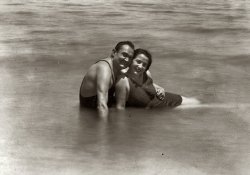
- J.M. Long's Store
- ... taken just before the war but not earlier than the fall of 1937, because the car in the picture is a rather pristine 1938 Pontiac 6 ... Posted by adamgilson - 05/09/2015 - 10:04am -
























